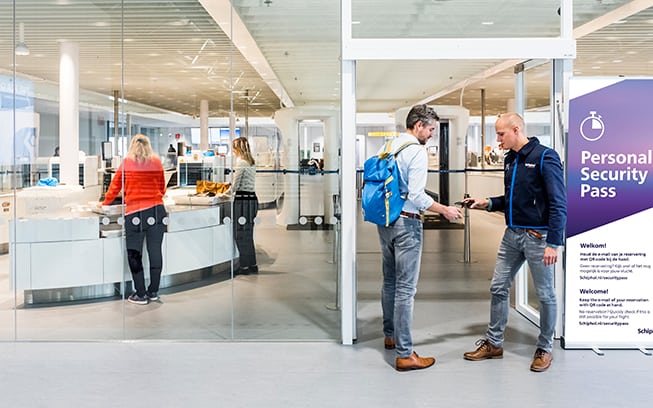For three weeks in late 2017, passengers flying from Amsterdam Airport Schiphol (AMS) to one of several European markets during designated times could take part in the Personal Security Pass pilot project, through which they could sign up to reserve a time slot for going through security.
Sign-ups could be reserved anywhere from four days to 75 minutes before departure, either on the airport’s website or through its Schiphol app. Those who did sign up passed through an entry gate designed specifically for the purpose of individualized security screenings.
Jackie Coburn, an associate principal in the Toronto office of !Arup, says if it catches on and comes to the United States, it could streamline security staffing and improve the customer experience by removing the variable amount of time it takes to clear security.
Carry that forward, Coburn says, and one could see a day where scheduling a time with an agent would allow for not just dealing with security clearance but the checking of bags and any immigration needs.
“That requires some coordination between various different agencies and service providers, but that would reduce the number of touch points,” she says. “If those could be consolidated into a single moment and you would be able to schedule it, you would have a far superior experience because it’s predictable and simple.”
Streamlined Process Would Change Design
With technology enhancements, security requirements and other yet-to-be-determined factors affecting their work, airport designers, architects and consultants are well into planning what future airports might look like.
Matt Needham, vice president and regional leader in HOK’s aviation and transportation division, says check-in and ticketing are going to change. For the last quarter century, he says, centralization has been the trend. Large security checkpoints in even larger iconic mega-terminals have dominated the landscape. But while some of these facilities are magnificent, he says they have a tendency to lose any sense of human scale.
In recent years he’s noted that passengers may want fewer centralized solutions and more choices. Look at ticketing: “We’ve got myriad ways people can use ticketing functions and not just how but where,” he says. “When you start to understand that is how passengers want to customize their experiences, when you start to decentralize their experiences and you start to provide choices, the human scale can really start to show up.”
Same with security. The Transportation Security Administration, he says, has been testing walk-through portals that would eliminate the need for passengers to place carry-on bags on a belt and then reclaim them.
Tom Rossbach, national aviation architecture leader with infrastructure firm HNTB Corp., agrees the pre-security experience will likely continue shifting. There already are more unmonitored stations offering self-service bag tags, fewer ticket counters and more self-service options.
This is already the case at some airports. At !Tampa International Airport (TPA), HNTB designed curbside express lanes where passengers without checked baggage can go straight to security.
Changes Should Include Customer Service Focus
Whatever changes are coming, they should be focused on providing better customer service, notes Eliot Lees, a vice president in ICF International’s Boston office, where he leads the group working on customer-experience planning.
With respect to the physical infrastructure of an airport, Lees says, airports must figure out how to integrate emerging technologies while being flexible enough to realize that nothing is static.
“What is envisioned today may be very different 10 years from now,” he says. “So this is trying to use facility planning and building design as a piece of delivering enhanced passenger experience.”
Lees suspects big data and predictive analytics will be put to better use in airports going forward. Many airports are using data now to post wait times, but that’s reactive, not proactive, Lees says.
At !Copenhagen Kastrup Airport (CPH), he says, the airport used its data and its stakeholder relationships to design a new taxi-queuing system. Officials there use the data to predict how many people within short timeframes will want to use a taxi and communicate that information to the taxi companies working at the airport.
Many of these theories are echoed in a research report published by the architectural, design and planning firm !Gensler, which reviewed existing white papers, surveys and studies on the passenger experience, changing revenue models and sustainability.
Customer-centric change throughout the security and terminal processes must continue, according to the report.
“The present-day airport is about waiting,” the report concludes. “Wait to park. Wait to check in. Wait to be screened. Wait to board. The near-future airport will be about moving. Passengers will experience a personalized journey through the airport, with increasingly seamless transitions and blurred lines between terminal spaces as security becomes ‘invisible’ and services become tech-enabled and individualized.”
Editor’s note: The full version of this article appears in the February 2018 issue of ARN Magazine. Click here to subscribe.






